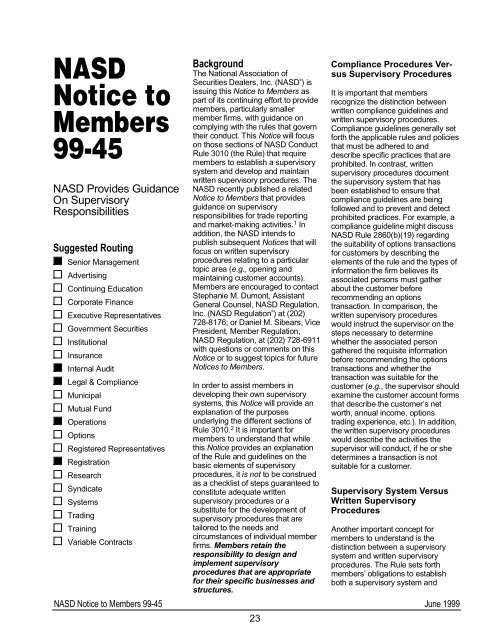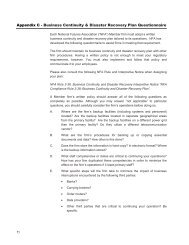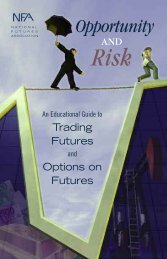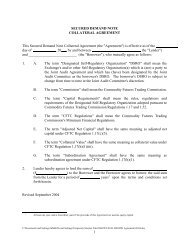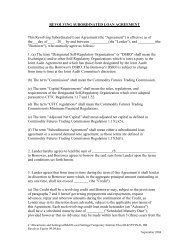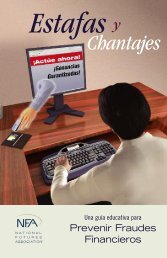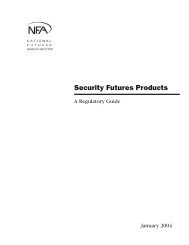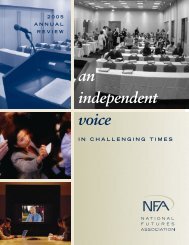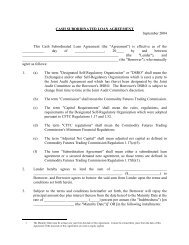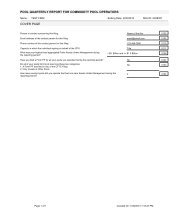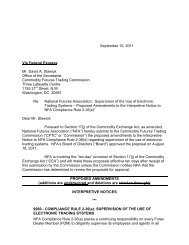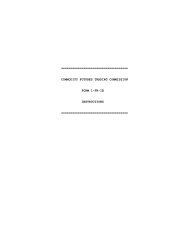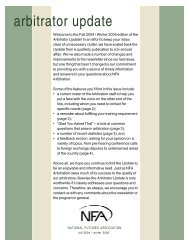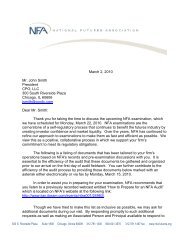NASD Notice to Members 99-45 - National Futures Association
NASD Notice to Members 99-45 - National Futures Association
NASD Notice to Members 99-45 - National Futures Association
You also want an ePaper? Increase the reach of your titles
YUMPU automatically turns print PDFs into web optimized ePapers that Google loves.
<strong>NASD</strong><br />
<strong>Notice</strong> <strong>to</strong><br />
<strong>Members</strong><br />
<strong>99</strong>-<strong>45</strong><br />
<strong>NASD</strong> Provides Guidance<br />
On Superv i s o ry<br />
R e s p o n s i b i l i t i e s<br />
Suggested Routing<br />
Senior Management<br />
A d v e r t i s i n g<br />
Continuing Education<br />
Corporate Finance<br />
Executive Representatives<br />
Government Securities<br />
I n s t i t u t i o n a l<br />
I n s u r a n c e<br />
Internal Audit<br />
Legal & Compliance<br />
M u n i c i p a l<br />
Mutual Fund<br />
O p e r a t i o n s<br />
O p t i o n s<br />
Registered Representatives<br />
R e g i s t r a t i o n<br />
R e s e a r c h<br />
S y n d i c a t e<br />
S y s t e m s<br />
T r a d i n g<br />
T r a i n i n g<br />
Variable Contracts<br />
Background<br />
The <strong>National</strong> <strong>Association</strong> of<br />
Securities Dealers, Inc. (<strong>NASD</strong> ® ) is<br />
issuing this <strong>Notice</strong> <strong>to</strong> <strong>Members</strong> a s<br />
part of its continuing effort <strong>to</strong> provide<br />
members, particularly smaller<br />
member firms, with guidance on<br />
complying with the rules that govern<br />
their conduct. This N o t i c ewill focus<br />
on those sections of <strong>NASD</strong> Conduct<br />
Rule 3010 (the Rule) that require<br />
members <strong>to</strong> establish a supervisory<br />
system and develop and maintain<br />
written supervisory procedures. The<br />
<strong>NASD</strong> recently published a related<br />
<strong>Notice</strong> <strong>to</strong> <strong>Members</strong> that provides<br />
guidance on supervisory<br />
responsibilities for trade reporting<br />
and market-making activities. 1 I n<br />
addition, the <strong>NASD</strong> intends <strong>to</strong><br />
publish subsequent N o t i c e sthat will<br />
focus on written supervisory<br />
procedures relating <strong>to</strong> a particular<br />
<strong>to</strong>pic area (e . g ., opening and<br />
maintaining cus<strong>to</strong>mer accounts).<br />
<strong>Members</strong> are encouraged <strong>to</strong> contact<br />
Stephanie M. Dumont, Assistant<br />
General Counsel, <strong>NASD</strong> Regulation,<br />
Inc. (<strong>NASD</strong> Regulation ® ) at (202)<br />
728-8176; or Daniel M. Sibears, Vice<br />
President, Member Regulation,<br />
<strong>NASD</strong> Regulation, at (202) 728-6911<br />
with questions or comments on this<br />
N o t i c eor <strong>to</strong> suggest <strong>to</strong>pics for future<br />
<strong>Notice</strong>s <strong>to</strong> <strong>Members</strong>.<br />
In order <strong>to</strong> assist members in<br />
developing their own supervisory<br />
systems, this N o t i c ewill provide an<br />
explanation of the purposes<br />
underlying the different sections of<br />
Rule 3010. 2 It is important for<br />
members <strong>to</strong> understand that while<br />
this N o t i c eprovides an explanation<br />
of the Rule and guidelines on the<br />
basic elements of supervisory<br />
procedures, it is not <strong>to</strong> be construed<br />
as a checklist of steps guaranteed <strong>to</strong><br />
constitute adequate written<br />
supervisory procedures or a<br />
substitute for the development of<br />
supervisory procedures that are<br />
tailored <strong>to</strong> the needs and<br />
circumstances of individual member<br />
firms. <strong>Members</strong> retain the<br />
responsibility <strong>to</strong> design and<br />
implement supervisory<br />
procedures that are appropriate<br />
for their specific businesses and<br />
s t r u c t u r e s .<br />
<strong>NASD</strong> <strong>Notice</strong> <strong>to</strong> <strong>Members</strong> <strong>99</strong>-<strong>45</strong> June 1<strong>99</strong>9<br />
23<br />
Compliance Procedures Versus<br />
Supervisory Procedures<br />
It is important that members<br />
recognize the distinction between<br />
written compliance guidelines and<br />
written supervisory procedures.<br />
Compliance guidelines generally set<br />
forth the applicable rules and policies<br />
that must be adhered <strong>to</strong> and<br />
describe specific practices that are<br />
prohibited. In contrast, written<br />
supervisory procedures document<br />
the supervisory system that has<br />
been established <strong>to</strong> ensure that<br />
compliance guidelines are being<br />
followed and <strong>to</strong> prevent and detect<br />
prohibited practices. For example, a<br />
compliance guideline might discuss<br />
<strong>NASD</strong> Rule 2860(b)(19) regarding<br />
the suitability of options transactions<br />
for cus<strong>to</strong>mers by describing the<br />
elements of the rule and the types of<br />
information the firm believes its<br />
associated persons must gather<br />
about the cus<strong>to</strong>mer before<br />
recommending an options<br />
transaction. In comparison, the<br />
written supervisory procedures<br />
would instruct the supervisor on the<br />
steps necessary <strong>to</strong> determine<br />
whether the associated person<br />
gathered the requisite information<br />
before recommending the options<br />
transactions and whether the<br />
transaction was suitable for the<br />
cus<strong>to</strong>mer (e . g ., the supervisor should<br />
examine the cus<strong>to</strong>mer account forms<br />
that describe the cus<strong>to</strong>mer’s net<br />
worth, annual income, options<br />
trading experience, etc.). In addition,<br />
the written supervisory procedures<br />
would describe the activities the<br />
supervisor will conduct, if he or she<br />
determines a transaction is not<br />
suitable for a cus<strong>to</strong>mer.<br />
Supervisory System Versus<br />
Written Supervisory<br />
Procedures<br />
Another important concept for<br />
members <strong>to</strong> understand is the<br />
distinction between a supervisory<br />
system and written supervisory<br />
procedures. The Rule sets forth<br />
members’ obligations <strong>to</strong> establish<br />
both a supervisory system and
written supervisory procedures.<br />
Written supervisory procedures are a<br />
critical part of an overall supervisory<br />
system. The written supervisory<br />
procedures document the<br />
supervisory system that the firm has<br />
established. For example, a<br />
supervisory system may include<br />
elements such as au<strong>to</strong>mated<br />
exception reports and surveillance<br />
programs that moni<strong>to</strong>r for unusual<br />
trading activity in cus<strong>to</strong>mer accounts.<br />
The written supervisory procedures<br />
would instruct the supervisor on<br />
which reports produced by the<br />
surveillance system the supervisor is<br />
<strong>to</strong> review as part of his or her<br />
supervisory responsibilities, including<br />
a description of how often these<br />
reports should be reviewed, the<br />
steps <strong>to</strong> be taken if suspicious<br />
activity is discovered, and how <strong>to</strong><br />
document the supervisor’s oversight<br />
a c t i v i t i e s .<br />
Supervisory System And<br />
Written Procedures -<br />
Rule 3010(a) And (b)<br />
Regardless of its size or complexity,<br />
each member must adopt and<br />
implement a supervisory system that<br />
is tailored specifically <strong>to</strong> the<br />
member’s business and must<br />
address the activities of all its<br />
registered representatives and<br />
associated persons. S u p e r v i s o r y<br />
procedures must be in writing a n d<br />
must be reasonably designed <strong>to</strong><br />
achieve compliance with applicable<br />
securities laws and rules and the<br />
rules of the <strong>NASD</strong> (hereinafter<br />
“securities laws”). U l t i m a t e<br />
responsibility for supervision<br />
rests with the member.<br />
Tailored To The Member’s<br />
B u s i n e s s<br />
To fulfill its obligations <strong>to</strong> establish<br />
and maintain a supervisory system, a<br />
member must determine the types of<br />
business it conducts, how the firm is<br />
organized and operated, and the<br />
current regula<strong>to</strong>ry requirements. This<br />
analysis will enable the member <strong>to</strong><br />
design a supervisory system that is<br />
current and appropriately tailored <strong>to</strong><br />
its specific attributes and structure.<br />
Fac<strong>to</strong>rs that should be considered in<br />
this analysis include, among other<br />
things, a review of the member’s:<br />
• product lines and cus<strong>to</strong>mer<br />
base (e . g ., institutional vs. retail);<br />
• number and geographic location<br />
of offices and personnel;<br />
• existing reporting systems,<br />
operating units, and<br />
organizational structures;<br />
• experience of personnel,<br />
including whether the fir m<br />
employs persons who should be<br />
subject <strong>to</strong> heightened supervisory<br />
procedures due <strong>to</strong> a his<strong>to</strong>ry of<br />
cus<strong>to</strong>mer complaints, disciplinary<br />
actions, or arbitration<br />
proceedings; and<br />
• applicable regula<strong>to</strong>ry<br />
requirements, including specific<br />
activities required (e . g ., principal<br />
approval of transactions) and<br />
s p e c i fic records required <strong>to</strong> be<br />
created and maintained (e . g .,<br />
new account documentation) in<br />
each product or operational area.<br />
Once a thorough review and analysis<br />
of these fac<strong>to</strong>rs has been conducted,<br />
the firm can then establish the<br />
framework of its supervisory system,<br />
taking in<strong>to</strong> consideration, among<br />
other things:<br />
• the availability, location, and<br />
q u a l i fications of registered<br />
principals and, where<br />
appropriate, representatives <strong>to</strong> be<br />
assigned supervisory<br />
r e s p o n s i b i l i t i e s ;<br />
• the importance of clear lines of<br />
authority, accountability, and<br />
r e s p o n s i b i l i t y ;<br />
• the maintenance of records and<br />
other documentation that will<br />
permit both the firm and<br />
regula<strong>to</strong>rs <strong>to</strong> determine how and<br />
by whom supervisory obligations<br />
are being discharged;<br />
• the technological environment in<br />
which the firm operates; and<br />
• the need <strong>to</strong> provide for the<br />
periodic evaluation of the fir m ’ s<br />
system and procedures such that<br />
both will continue <strong>to</strong> accurately<br />
r e flect the firm’s business and<br />
current regula<strong>to</strong>ry requirements.<br />
Written Procedures<br />
Once a member has designed its<br />
supervisory system, Rule 3010(b)<br />
requires the member <strong>to</strong> memorialize<br />
this system in writing and implement<br />
and enforce these written<br />
procedures. It is important that<br />
supervisory procedures be set forth<br />
in writing for several reasons. Written<br />
procedures provide the personnel<br />
subject <strong>to</strong> the supervisory system, as<br />
well as those responsible for<br />
implementing it, a document that<br />
explains the supervisory system and<br />
their specific responsibilities. Written<br />
procedures also provide stability and<br />
continuity as personnel take on<br />
different responsibilities or leave the<br />
firm. In addition, senior management<br />
can use the written procedures <strong>to</strong><br />
determine whether personnel are<br />
complying with the supervisory<br />
system by auditing compliance with<br />
the written procedures. Accordingly,<br />
the Rule requires that a copy of the<br />
member’s written supervisory<br />
procedures, or the relevant parts, be<br />
maintained at each office of<br />
supervisory jurisdiction and any other<br />
location where supervision occurs.<br />
It is equally important that the written<br />
supervisory procedures clearly<br />
identify who has supervisory<br />
responsibilities. A member must<br />
keep a record of each associated<br />
person who has supervisory<br />
responsibilities and the date each<br />
person was assigned those<br />
responsibilities. This must include the<br />
titles, registration status, and<br />
locations of the supervisory<br />
personnel. The written procedures<br />
also must include the business line<br />
and applicable securities laws for<br />
which each supervisor is<br />
responsible. When developing its<br />
written procedures <strong>to</strong> include this<br />
<strong>NASD</strong> <strong>Notice</strong> <strong>to</strong> <strong>Members</strong> <strong>99</strong>-<strong>45</strong> June 1<strong>99</strong>9<br />
24
information, a member should keep<br />
in mind that the purpose of this rule<br />
is <strong>to</strong> allow for personnel at the fir m ,<br />
as well as regula<strong>to</strong>rs, <strong>to</strong> easily<br />
determine who is responsible for<br />
supervising a particular area and the<br />
time period for which the person was<br />
assigned the supervisory<br />
responsibility.<br />
Written supervisory procedures are<br />
not static documents that can be<br />
used for an indefinite period of time<br />
without modification. A firm’s existing<br />
supervisory system may become<br />
outdated or ineffective as a result of<br />
changes in the firm’s business lines,<br />
products, practices, or new or<br />
amended securities laws. In such<br />
instances, the written supervisory<br />
procedures must be updated <strong>to</strong><br />
properly reflect any necessary<br />
changes <strong>to</strong> the supervisory system.<br />
Rule 3010(b) does provide a<br />
member with a reasonable amount<br />
of time after changes occur <strong>to</strong> amend<br />
its written supervisory procedures.<br />
Reasonableness, however, is<br />
determined in light of the relevant<br />
facts and circumstances. For<br />
example, an amendment <strong>to</strong> rules<br />
pertaining <strong>to</strong> a type of business that<br />
a member conducts daily (e . g .,<br />
market making) should be<br />
incorporated in<strong>to</strong> the supervisory<br />
system and written procedures prior<br />
<strong>to</strong> the effective date of the rule<br />
change. Changes in a title or other<br />
administrative matters, on the other<br />
hand, may not warrant an immediate<br />
change and could be updated on a<br />
periodic basis.<br />
It is crucial that all persons<br />
associated with a member be<br />
informed of any changes in the<br />
supervisory system and applicable<br />
written procedures. The Rule,<br />
therefore, requires members <strong>to</strong><br />
inform all associated persons of such<br />
changes. This can be accomplished,<br />
for example, by distributing updates<br />
<strong>to</strong> the relevant sections of the written<br />
supervisory procedures.<br />
Reasonably Designed To Achieve<br />
C o m p l i a n c e<br />
The Rule requires that a member’s<br />
supervisory system be reasonably<br />
designed <strong>to</strong> achieve compliance with<br />
applicable laws and regulations. This<br />
standard recognizes that a<br />
supervisory system cannot<br />
guarantee firm-wide compliance with<br />
all laws and regulations. However,<br />
this standard does require that the<br />
system be a product of sound<br />
thinking and within the bounds of<br />
common sense, taking in<strong>to</strong><br />
consideration the fac<strong>to</strong>rs that are<br />
unique <strong>to</strong> a member’s business<br />
described above.<br />
Because reasonableness is<br />
determined in light of the particular<br />
facts and circumstances surrounding<br />
a situation, it is difficult <strong>to</strong> articulate<br />
with any specificity a standard that<br />
would be applicable in all<br />
circumstances. As practical, the<br />
<strong>NASD</strong> will identify certain procedures<br />
it believes are reasonable, as well as<br />
those practices that it finds are not<br />
reasonable. For example, in N o t i c e<br />
<strong>to</strong> <strong>Members</strong> 98-96, the <strong>NASD</strong> noted<br />
that written supervisory procedures<br />
that instruct a supervisor <strong>to</strong> initial<br />
order tickets and blotters or <strong>to</strong> fill out<br />
review logs <strong>to</strong> document a review are<br />
reasonable, while procedures that<br />
merely recite the applicable rules or<br />
fail <strong>to</strong> describe the steps the firm will<br />
take when potential deficiencies are<br />
i d e n t i fied are not reasonable. 3<br />
<strong>Members</strong> Are Responsible For<br />
S u p e r v i s i o n<br />
The ultimate responsibility for<br />
supervision lies with the member.<br />
This responsibility, however, does<br />
not preclude a member from<br />
implementing a supervisory system<br />
designed by another party, which<br />
could include, for example, a<br />
computer software program that<br />
detects excessive trading in<br />
cus<strong>to</strong>mers’ accounts. If a member<br />
chooses <strong>to</strong> implement such a<br />
system, though, it must make its own<br />
determination that the system<br />
implemented is current and<br />
reasonably designed <strong>to</strong> achieve<br />
compliance with the securities laws.<br />
This may include, for example,<br />
moni<strong>to</strong>ring the system <strong>to</strong> ensure that<br />
it functions as designed.<br />
Minimum Requirements Of A<br />
Supervisory System - Rule<br />
3010(a)<br />
Although a supervisory system must<br />
be tailored <strong>to</strong> meet the member’s<br />
s p e c i fic structure, the <strong>NASD</strong> has<br />
i d e n t i fied certain elements that must<br />
be included in every member’s<br />
supervisory system. While each<br />
element will be discussed<br />
individually, members should keep in<br />
mind that each of these elements<br />
must be incorporated in<strong>to</strong> an overall<br />
supervisory system that is<br />
reasonably designed <strong>to</strong> achieve<br />
compliance with the securities laws<br />
and rules. <strong>Members</strong> must be<br />
cognizant of how these elements<br />
affect and are affected by other<br />
requirements in the Rule and other<br />
rules and statu<strong>to</strong>ry provisions.<br />
Furthermore, a member is not<br />
relieved of its supervisory<br />
obligations by merely<br />
incorporating each of these<br />
minimum elements in<strong>to</strong> its<br />
supervisory system.<br />
Designating Principals<br />
Responsible For Supervision -<br />
Rule 3010(a)(2)<br />
Rule 3010(a)(2) requires that a<br />
member assign responsibility for<br />
each type of business that the<br />
member conducts <strong>to</strong> one or more<br />
principals. This requirement is limited<br />
<strong>to</strong> those types of business that<br />
require registration as a<br />
broker/dealer. If a member also<br />
conducts a type of business that<br />
does not require broker/dealer<br />
registration, this requirement would<br />
not apply <strong>to</strong> that particular type of<br />
business, however, other regula<strong>to</strong>ry<br />
requirements, including, for example,<br />
state insurance laws, may apply.<br />
The Rule requires that principals be<br />
appropriately registered and vested<br />
with the authority <strong>to</strong> carry out the<br />
supervision for which they are<br />
<strong>NASD</strong> <strong>Notice</strong> <strong>to</strong> <strong>Members</strong> <strong>99</strong>-<strong>45</strong> June 1<strong>99</strong>9<br />
25
esponsible. Persons responsible for<br />
supervising a particular type of<br />
business, therefore, must be<br />
registered as principals for that type<br />
of business. They must also have the<br />
authority <strong>to</strong> implement the written<br />
supervisory procedures and take any<br />
other action necessary <strong>to</strong> fulfill their<br />
r e s p o n s i b i l i t i e s .<br />
This provision seeks <strong>to</strong> achieve<br />
several regula<strong>to</strong>ry objectives:<br />
• <strong>to</strong> ensure that there is an<br />
i d e n t i fiable individual who has<br />
ultimate responsibility for<br />
implementing the member’s<br />
supervisory system and written<br />
procedures for each type of<br />
business the member conducts;<br />
• <strong>to</strong> ensure that the individual<br />
responsible for a particular type of<br />
business possesses the<br />
knowledge and experience<br />
necessary <strong>to</strong> supervise the<br />
business; and<br />
• <strong>to</strong> ensure that the person<br />
responsible for supervision<br />
actually has the authority <strong>to</strong><br />
supervise.<br />
A member would not be in<br />
compliance with the Rule, for<br />
example, if a person registered<br />
solely as a general securities<br />
principal was responsible for<br />
supervising the preparation of<br />
financial reports that are filed with<br />
regula<strong>to</strong>rs. In addition, a member<br />
would not be in compliance with the<br />
Rule if a general securities principal<br />
was responsible for supervising<br />
general securities activities, but was<br />
not given the requisite authority <strong>to</strong><br />
f u l fill the supervisory obligations. This<br />
could occur, for example, if the<br />
principal was not granted access <strong>to</strong><br />
those documents necessary <strong>to</strong><br />
determine whether a registered<br />
representative was complying with<br />
the <strong>NASD</strong>’s suitability rules, or if the<br />
principal was not permitted <strong>to</strong> take<br />
action against or place under closer<br />
supervision a person that failed <strong>to</strong><br />
follow the firm’s compliance<br />
guidelines. Having the requisite<br />
authority <strong>to</strong> fulfill supervisory<br />
responsibilities generally means that<br />
the person charged with the<br />
responsibilities can exercise power<br />
<strong>to</strong> affect the conduct of a person<br />
whose behavior is at issue. This,<br />
however, does not necessarily mean<br />
that the supervisor must have the<br />
ability <strong>to</strong> terminate a person whose<br />
conduct is at issue. 4<br />
Designating Offices Of<br />
Supervisory Jurisdiction - Rule<br />
3 0 1 0 ( a ) ( 3 )<br />
Certain types of activities (e . g ., order<br />
execution) are sufficiently vested<br />
with regula<strong>to</strong>ry significance that the<br />
locations where members conduct<br />
these types of activities require<br />
special recognition and attention.<br />
Such locations or offices are known<br />
as offices of supervisory jurisdiction<br />
(OSJ). Paragraph (g)(1) of the Rule<br />
lists the types of activities that have<br />
been identified by the <strong>NASD</strong> as<br />
requiring significant supervisory<br />
attention and defines the term “offic e<br />
of supervisory jurisdiction” as any<br />
o f fice of a member where one or<br />
more of the delineated activities<br />
o c c u r .<br />
A member must designate as an<br />
OSJ any office that conducts any of<br />
the functions listed in that section. A<br />
member also must designate any<br />
other office as an OSJ, if such<br />
designation is necessary <strong>to</strong> enable<br />
the member <strong>to</strong> fulfill its supervisory<br />
obligations. In making this<br />
determination, members must<br />
consider several fac<strong>to</strong>rs that are<br />
listed in the Rule. These fac<strong>to</strong>rs<br />
include whether the activities<br />
conducted at the office involve<br />
regular contact with public<br />
cus<strong>to</strong>mers, the distance of the offic e<br />
from another OSJ, and whether the<br />
activities conducted at the office are<br />
diverse or complex.<br />
In summary, in order <strong>to</strong> design a<br />
supervisory system that is in<br />
compliance with this paragraph of<br />
the Rule, a member must:<br />
• review the types of activities that<br />
occur at each of its offic e s ;<br />
• determine for each offic e<br />
whether any of the activities listed<br />
in paragraph (g)(1) of Rule 3010<br />
are conducted at the office; if one<br />
or more of the activities listed are<br />
conducted, then the member<br />
must designate that office as an<br />
OSJ; and<br />
• determine, after considering the<br />
fac<strong>to</strong>rs listed in paragraph (a)(3),<br />
if it is necessary, in order <strong>to</strong> fulfil l<br />
its supervisory obligations, <strong>to</strong><br />
designate any other offices as<br />
O S J .<br />
<strong>Members</strong>’ obligations under this<br />
paragraph of the Rule, as well as<br />
their obligations under other<br />
paragraphs of the Rule, are ongoing.<br />
Thus, as events occur that change<br />
the structure of the firm, such as<br />
changing the types of business that<br />
are conducted in different locations,<br />
adding registered personnel, or<br />
opening, moving or closing offic e s ,<br />
members must consider the effects<br />
that these events will have on OSJ<br />
designation requirements. In this<br />
regard, members must have systems<br />
and procedures in place <strong>to</strong> determine<br />
the effects of such events or<br />
c h a n g e s .<br />
Assigning Supervisors For<br />
Registered Representatives And<br />
Designating OSJ/Non-OSJ Branch<br />
Supervisors - Rule 3010(a)(5) And<br />
(a)(4)<br />
Paragraph (a)(5) of the Rule requires<br />
that e a c h r e g i s t e r e dp e r s o nb e<br />
assigned <strong>to</strong> at least one supervisor.<br />
Thus, it is irrelevant whether the<br />
person <strong>to</strong> be supervised is a<br />
registered representative or a<br />
registered principal, or that the<br />
registered person is part of the senior<br />
management of the member.<br />
When designating supervisory<br />
personnel, it is important <strong>to</strong><br />
remember that a supervisor can only<br />
be responsible for supervising those<br />
activities for which they are qualifie d .<br />
For example, a supervisor with a<br />
q u a l i fication limited <strong>to</strong> investment<br />
company products and variable<br />
contracts cannot supervise a<br />
<strong>NASD</strong> <strong>Notice</strong> <strong>to</strong> <strong>Members</strong> <strong>99</strong>-<strong>45</strong> June 1<strong>99</strong>9<br />
26
egistered person conducting general<br />
securities activities. In such a<br />
situation, the supervisor could<br />
supervise the registered person’s<br />
activity in investment company<br />
products and variable contracts, but<br />
an appropriately qualified supervisor<br />
would have <strong>to</strong> supervise the<br />
registered person’s other activities.<br />
The requirement that every<br />
registered person be assigned at<br />
least one supervisor serves several<br />
functions. It provides the person<br />
being supervised with a clear line of<br />
authority and specifically identifies for<br />
the supervisor the persons for which<br />
he or she has responsibility. In<br />
addition, this requirement recognizes<br />
the obvious fact that a supervisory<br />
system reasonably designed <strong>to</strong><br />
achieve compliance with the<br />
securities laws does not permit<br />
persons <strong>to</strong> supervise themselves.<br />
In summary, in order <strong>to</strong> design a<br />
supervisory system that is in<br />
compliance with this paragraph of<br />
the Rule, a member must:<br />
• determine the number of<br />
registered persons associated<br />
with it;<br />
• determine the type(s) of activity<br />
each registered person conducts;<br />
• determine the qualifications of<br />
each person assigned<br />
supervisory responsibility;<br />
• assign each registered person<br />
<strong>to</strong> one or more supervisors that<br />
are qualified <strong>to</strong> supervise the<br />
activities of the registered person;<br />
a n d<br />
• continue <strong>to</strong> moni<strong>to</strong>r the activities<br />
of registered persons and the<br />
q u a l i fications of their assigned<br />
supervisors <strong>to</strong> ensure that the<br />
supervisors are properly qualifie d .<br />
Paragraph (a)(4) of the Rule requires<br />
members <strong>to</strong> assign each OSJ at<br />
least one principal with the authority<br />
<strong>to</strong> carry out the supervisory<br />
responsibilities conducted at the<br />
OSJ. Each branch office that is not<br />
designated as an OSJ also must<br />
have at least one supervisor<br />
assigned <strong>to</strong> it. In this situation,<br />
certain supervisory t a s k smay be<br />
delegated <strong>to</strong> a registered<br />
representative. However, in all<br />
cases, ultimate supervisory<br />
r e s p o n s i b i l i t yfor every registered<br />
and unregistered branch office must<br />
be assigned <strong>to</strong> one or more<br />
appropriately registered principals.<br />
Having one or more identifia b l e<br />
registered principals assigned <strong>to</strong><br />
supervise each OSJ provides clarity<br />
as <strong>to</strong> who is responsible for all of the<br />
supervisory obligations assigned <strong>to</strong><br />
each OSJ. For example, it provides<br />
persons working in an OSJ or being<br />
supervised from an OSJ with a clear<br />
line of authority and specific a l l y<br />
i d e n t i fies for the supervisor the areas<br />
and persons for which the supervisor<br />
has responsibility.<br />
Paragraph (a)(4) of the Rule also<br />
requires that the person or persons<br />
assigned responsibility for<br />
supervising an OSJ or a branch<br />
o f fice be a p p r o p r i a t e l yregistered <strong>to</strong><br />
f u l fill the supervisory obligations<br />
assigned <strong>to</strong> the office. Therefore,<br />
those individuals with ultimate<br />
responsibility for supervising each<br />
type of business conducted at the<br />
o f fice or supervised from the offic e<br />
must be registered as a principal for<br />
that type of business. Thus, a<br />
member must ensure that the<br />
supervisor(s) assigned <strong>to</strong> an OSJ are<br />
appropriately qualified <strong>to</strong> supervise<br />
the activities conducted or<br />
supervised from that OSJ. For<br />
example, a principal with limited<br />
q u a l i fications could not be assigned<br />
as the sole supervisor of an OSJ that<br />
conducted activities for which the<br />
principal was not qualified. In such a<br />
situation, another principal, whose<br />
q u a l i fications correspond <strong>to</strong> the other<br />
types activities, must be assigned <strong>to</strong><br />
the OSJ. In addition, these persons<br />
must have the authority <strong>to</strong> implement<br />
the written supervisory procedures<br />
and take any other action required <strong>to</strong><br />
f u l fill the supervisory obligations<br />
assigned <strong>to</strong> the office.<br />
In summary, in order <strong>to</strong> design a<br />
supervisory system that is in<br />
compliance with this paragraph of<br />
the Rule, a member must:<br />
• determine which of its offic e s<br />
are designated as OSJ;<br />
• determine the type of activity<br />
conducted at or supervised from<br />
each OSJ;<br />
• determine the qualifications of<br />
the person assigned supervisory<br />
responsibility;<br />
• assign <strong>to</strong> each OSJ or non-OSJ<br />
branch one or more supervisors<br />
that are qualified <strong>to</strong> supervise the<br />
activities of the office;<br />
• provide supervisors with the<br />
authority <strong>to</strong> fulfill the supervisory<br />
obligations assigned <strong>to</strong> them; and<br />
• continue <strong>to</strong> moni<strong>to</strong>r the activities<br />
of registered persons and the<br />
q u a l i fications of their assigned<br />
supervisors <strong>to</strong> ensure that the<br />
supervisors are qualified <strong>to</strong><br />
s u p e r v i s e .<br />
Determining Qualifications Of<br />
Supervisory Personnel - Rule<br />
3 0 1 0 ( a ) ( 6 )<br />
Paragraph (a)(6) of the Rule sets the<br />
standard for determining the<br />
q u a l i fications of supervisors. The<br />
Rule requires that members make<br />
reasonable efforts <strong>to</strong> determine that<br />
all supervisory personnel are<br />
q u a l i fied <strong>to</strong> fulfill their assigned<br />
responsibilities. At a minimum, the<br />
supervisor must be properly licensed<br />
<strong>to</strong> conduct the assigned<br />
responsibilities. However, passing<br />
the appropriate licensing<br />
examination does not, in and of itself,<br />
qualify a supervisor. <strong>Members</strong><br />
should determine that supervisors<br />
understand and can effectively<br />
conduct their requisite<br />
responsibilities. In this regard,<br />
members should consider the<br />
experience the supervisor possesses<br />
or the training the supervisor has<br />
received.<br />
<strong>NASD</strong> <strong>Notice</strong> <strong>to</strong> <strong>Members</strong> <strong>99</strong>-<strong>45</strong> June 1<strong>99</strong>9<br />
27
Determining whether reasonable<br />
efforts have been made by a<br />
member <strong>to</strong> ascertain a supervisor’s<br />
q u a l i fications depends on the facts<br />
and circumstances surrounding the<br />
situation. For example, if a firm failed<br />
<strong>to</strong> determine whether a supervisor is<br />
properly registered for the type of<br />
activity the supervisor is responsible<br />
for overseeing, the firm would not be<br />
considered <strong>to</strong> have made a<br />
reasonable effort, given that a<br />
person’s registration status is readily<br />
available. In addition, merely relying<br />
on the representations made by a<br />
person about his or her qualific a t i o n s<br />
may not be sufficient if the member<br />
can confirm the representations<br />
without having <strong>to</strong> undertake extreme<br />
or excessive efforts. A member can<br />
contact the person’s current or<br />
former supervisors, especially when<br />
the supervisors are associated with<br />
the member.<br />
A member’s obligation <strong>to</strong> determine<br />
whether a supervisor is properly<br />
q u a l i fied <strong>to</strong> fulfill his or her<br />
supervisory duties is an ongoing<br />
obligation. Thus, a member that<br />
receives indications that a supervisor<br />
is having difficulty performing his or<br />
her supervisory functions would have<br />
an obligation <strong>to</strong> investigate <strong>to</strong><br />
determine whether such person can<br />
continue in a supervisory role. 5<br />
A member’s written supervisory<br />
procedures should identify those<br />
q u a l i fications it has deemed<br />
important in determining whether a<br />
supervisor can fulfill his or her<br />
assigned responsibilities, the<br />
procedures for determining whether<br />
the supervisor possesses such<br />
q u a l i fications and the methods for<br />
moni<strong>to</strong>ring the supervisor’s<br />
p e r f o r m a n c e .<br />
Annual Compliance Meeting -<br />
Rule 3010(a)(7)<br />
Paragraph (a)(7) of the Rule requires<br />
that each registered representative<br />
participate, at least once each year,<br />
in an interview or meeting at which<br />
compliance matters relevant <strong>to</strong> the<br />
particular representative are<br />
discussed. This requirement gives<br />
registered representatives the<br />
opportunity <strong>to</strong> regularly discuss<br />
compliance issues and assists the<br />
firm in ensuring that representatives<br />
remain current on changing<br />
compliance requirements or changes<br />
in the firm. These meetings can be<br />
held with representatives individually<br />
or with a group of representatives,<br />
and can be held at a central or<br />
regional location or at the member’s<br />
place of business. Matters other than<br />
compliance may also be discussed<br />
at the meeting. The member can<br />
designate other persons <strong>to</strong> conduct<br />
the meeting, however, m e m b e r s<br />
remain ultimately responsible for<br />
f u l filling the obligations under the<br />
Rule. Thus, at a minimum, members<br />
must review the presentation<br />
prepared by a third party <strong>to</strong><br />
determine that all the necessary<br />
<strong>to</strong>pics will be discussed at the<br />
m e e t i n g .<br />
The Rule provides members with<br />
substantial flexibility in implementing<br />
the compliance meeting. Depending<br />
on the method chosen, however,<br />
certain precautions must be taken <strong>to</strong><br />
comply with the Rule. For example, if<br />
a meeting is held with a group of<br />
registered representatives, the<br />
meeting must cover compliance<br />
matters that relate <strong>to</strong> the different<br />
types of activities that each of the<br />
representatives attending the<br />
meeting conduct. Relevant matters<br />
not addressed at the group meeting<br />
must be covered at an individual<br />
meeting or at another group session.<br />
Whether the meeting is conducted<br />
with each representative individually<br />
or through group meetings, each<br />
individual representative must be<br />
provided the opportunity <strong>to</strong> discuss<br />
compliance matters that relate <strong>to</strong> the<br />
types of activities he or she<br />
conducts.<br />
With respect <strong>to</strong> delivery mediums,<br />
the meeting can be conducted by<br />
video conference, interactive<br />
classroom setting, telephone, or<br />
other electronic means, provided that<br />
certain safeguards are in place.<br />
<strong>Members</strong> choosing <strong>to</strong> conduct<br />
compliance conferences other than<br />
in person must ensure that the<br />
communication forum used allows<br />
for interactive communication with<br />
the representative. This means, at a<br />
minimum, that attendees are able <strong>to</strong><br />
hear presenters live and, in an<br />
interactive environment, ask<br />
questions and engage in dialogue<br />
with the presenters. This does permit<br />
presenters <strong>to</strong> use supplemental<br />
learning and communications <strong>to</strong>ols,<br />
such as video tapes or computer<br />
programs that include informational<br />
or instructional materials.<br />
In addition <strong>to</strong> ensuring an interactive<br />
environment for all compliance<br />
conferences, members conducting<br />
such conferences through electronic<br />
means or aids may bear a<br />
heightened responsibility associated<br />
with such electronic communications.<br />
As with all compliance conferences,<br />
members must ensure that<br />
representatives scheduled <strong>to</strong> appear<br />
at a particular location in fact arrive at<br />
and are in attendance for the entire<br />
c o n f e r e n c e .<br />
A member’s written supervisory<br />
procedures should document the<br />
procedures for developing a meeting<br />
that discusses relevant compliance<br />
matters, determining when a<br />
representative must attend and<br />
c o n firming a representative’s<br />
attendance at a required compliance<br />
m e e t i n g .<br />
In summary, in order <strong>to</strong> design a<br />
supervisory system that is in<br />
compliance with this paragraph of<br />
the Rule, a member must:<br />
• confirm that each registered<br />
representative attended a<br />
compliance meeting within one<br />
year from the last compliance<br />
meeting attended;<br />
• identify those representatives<br />
that have not attended a<br />
compliance meeting at least once<br />
in the last year;<br />
• determine for each registered<br />
representative the types of<br />
activities that the representative<br />
c o n d u c t s ;<br />
<strong>NASD</strong> <strong>Notice</strong> <strong>to</strong> <strong>Members</strong> <strong>99</strong>-<strong>45</strong> June 1<strong>99</strong>9<br />
28
• develop a meeting, whether<br />
held on an individual basis or as<br />
a group, that discusses<br />
compliance matters relevant <strong>to</strong><br />
each type of activity conducted by<br />
the representative or<br />
representatives; and<br />
• determine what, if any, special<br />
safeguards must be in place<br />
depending on how the meeting is<br />
conducted (e . g ., video<br />
conferencing or contracting with a<br />
third party <strong>to</strong> conduct the<br />
m e e t i n g ) .<br />
Review Of Supervisory System -<br />
Rule 3010(a)(8)<br />
Rule 3010(a)(8) requires that at least<br />
one principal be designated <strong>to</strong> review<br />
the firm’s supervisory system,<br />
procedures, and internal inspections.<br />
If more than one principal is so<br />
designated, it must be clear which<br />
areas of the supervisory system<br />
each has been assigned <strong>to</strong> review.<br />
The purpose of this review is <strong>to</strong><br />
determine the effects of changes<br />
such as hiring additional registered<br />
persons, the departure of registered<br />
persons, commencing a new line of<br />
business (e . g ., market making), a<br />
change in ownership, or changes in<br />
the securities laws, on the member’s<br />
existing supervisory systems and<br />
procedures. A supervisory system<br />
and/or written procedures that are<br />
not current with regula<strong>to</strong>ry<br />
requirements or the structure and<br />
business activities of the member<br />
would not be reasonably designed <strong>to</strong><br />
achieve compliance with the<br />
securities laws.<br />
The Rule requires that one or more<br />
registered principals be specific a l l y<br />
assigned this responsibility. In this<br />
way, there is at least one person at<br />
each member who is responsible for<br />
reviewing and analyzing the effect of<br />
such changes on the member’s<br />
supervisory system and procedures<br />
as a whole. However, the utility of<br />
such a review is undermined if the<br />
problems or deficiencies discovered<br />
as a result are not addressed and<br />
corrected. The principal assigned <strong>to</strong><br />
conduct the review, therefore, also<br />
has the obligation <strong>to</strong> take action<br />
reasonably designed <strong>to</strong> achieve<br />
compliance with the securities laws<br />
or <strong>to</strong> recommend such action <strong>to</strong><br />
senior management. Thus, for<br />
example, if a principal assigned this<br />
responsibility discovers that the<br />
written supervisory procedures do<br />
not address all the types of<br />
businesses that the firm conducts,<br />
the principal must take action or<br />
recommend such action <strong>to</strong> senior<br />
management <strong>to</strong> correct this<br />
d e fic i e n c y .<br />
Internal Inspections - Rule<br />
3010(c)<br />
It is important that members not only<br />
review their supervisory systems and<br />
procedures <strong>to</strong> ensure that they are<br />
current and adequate, but also<br />
conduct inspections <strong>to</strong> determine<br />
whether the systems and procedures<br />
are being followed. Paragraph (c) of<br />
the Rule, therefore, requires<br />
members <strong>to</strong> annually review the<br />
businesses they conduct, and sets<br />
forth the standard for this review.<br />
The manda<strong>to</strong>ry annual review must<br />
be reasonably designed <strong>to</strong> assist<br />
members in detecting and preventing<br />
violations of the securities laws. The<br />
“reasonably” designed standard<br />
means, for example, that indications<br />
of problems, or “red flags,” must be<br />
investigated. When a member<br />
receives an indication of irregularities<br />
in a cus<strong>to</strong>mer’s account (e . g ., a<br />
compliance program indicates or a<br />
supervisor discovers a frequency of<br />
trading in a cus<strong>to</strong>mer’s account that<br />
exceeds the cus<strong>to</strong>mer’s normal level<br />
of trading), it must require that the<br />
account be examined <strong>to</strong> determine<br />
whether churning or some other<br />
violative conduct has occurred. If it<br />
does not, then that member’s<br />
examination procedures would not<br />
be reasonably designed <strong>to</strong> detect or<br />
prevent irregularities or abuses.<br />
The Rule also requires that each<br />
o f fice of a member be reviewed. The<br />
frequency of this review will depend<br />
on several fac<strong>to</strong>rs, including whether<br />
an office is designated as an OSJ. At<br />
a minimum, an OSJ must be<br />
reviewed every year, whereas<br />
branch offices are required <strong>to</strong> be<br />
reviewed in accordance with a stated<br />
cycle. In determining the inspection<br />
cycle for a branch office, a member<br />
must consider the nature and<br />
complexity of the securities activity<br />
for which the branch office is<br />
responsible, as well as the volume of<br />
business conducted at the office and<br />
the number of associated persons<br />
assigned <strong>to</strong> the office. Once a<br />
member determines its inspection<br />
cycle, it must document the cycle in<br />
its written supervisory and inspection<br />
p r o c e d u r e s .<br />
Some <strong>NASD</strong> members employ<br />
associated persons at offices that<br />
are not designated as OSJs and are<br />
not registered as branch offices. For<br />
purposes of this N o t i c e, such offic e s<br />
are referred <strong>to</strong> as “unregistered<br />
o f fices” and include any location at<br />
which a member is conducting a<br />
securities business that does not fall<br />
within the definition of OSJ or branch<br />
o f fice. Some associated persons<br />
working in these unregistered offic e s<br />
may be involved in other business<br />
enterprises, such as insurance, real<br />
estate sales, accounting, tax<br />
planning, or investment advisory<br />
services, and consequently may be<br />
c l a s s i fied for compensation purposes<br />
as part-time employees or<br />
independent contrac<strong>to</strong>rs. Some<br />
unregistered offices also operate as<br />
separate business entities under<br />
names other than those of the<br />
members. While the <strong>NASD</strong> does not<br />
encourage or discourage such<br />
arrangements, a large number of<br />
geographically diverse offic e s<br />
presents the potential that sales<br />
practice problems will not be as<br />
quickly identified as in larger,<br />
centralized branch offices. This<br />
increased potential must be taken<br />
in<strong>to</strong> account when drafting<br />
supervisory procedures.<br />
<strong>Members</strong> employing associated<br />
persons in unregistered offices are<br />
responsible for establishing and<br />
carrying out procedures that will<br />
subject these persons <strong>to</strong> effective<br />
supervision. To be effective, the<br />
<strong>NASD</strong> <strong>Notice</strong> <strong>to</strong> <strong>Members</strong> <strong>99</strong>-<strong>45</strong> June 1<strong>99</strong>9<br />
29
supervision must be designed <strong>to</strong><br />
moni<strong>to</strong>r securities-related activities<br />
and <strong>to</strong> detect and prevent regula<strong>to</strong>ry<br />
and compliance problems of<br />
associated persons working at<br />
unregistered offices. In this regard, a<br />
member’s supervisory responsibility<br />
would include, but not be limited <strong>to</strong>:<br />
• maintaining a record of the<br />
locations of all unregistered<br />
o f fices, which must be made<br />
available <strong>to</strong> regula<strong>to</strong>rs upon<br />
r e q u e s t ;<br />
• educating associated persons<br />
working from an unregistered<br />
o f fice as <strong>to</strong> their obligations <strong>to</strong> the<br />
firm and <strong>to</strong> the public, including<br />
prohibited sales practices;<br />
• maintaining regular and frequent<br />
professional contact with such<br />
individuals; and<br />
• implementing appropriate<br />
supervisory practices, such as<br />
records inspections and<br />
compliance audits at the<br />
associated persons’ places of<br />
employment, <strong>to</strong> ensure that their<br />
methods of business and day-<strong>to</strong>day<br />
operations comply with<br />
applicable rules and<br />
r e q u i r e m e n t s .<br />
To fulfill these obligations, a fir m<br />
should consider whether the number<br />
and location of its registered<br />
principals are adequate <strong>to</strong> properly<br />
supervise its unregistered offic e<br />
personnel effectively.<br />
The Rule does not specify the<br />
frequency of inspections for<br />
unregistered offices, but in order <strong>to</strong><br />
f u l fill the general obligation <strong>to</strong><br />
supervise, such inspections should<br />
be conducted according <strong>to</strong> a regular<br />
schedule. The frequency and scope<br />
of inspections should be determined<br />
based on fac<strong>to</strong>rs such as the nature<br />
and volume of business conducted<br />
at the office and the nature and<br />
extent of contact with cus<strong>to</strong>mers. A<br />
non-OSJ office that supervises one<br />
or more unregistered offices should<br />
be inspected at least annually.<br />
Inspections of unregistered offic e s<br />
should include, among other things,<br />
a review of any on-site cus<strong>to</strong>mer<br />
account documentation and other<br />
books and records, meetings with<br />
individual registered representatives<br />
<strong>to</strong> discuss the products they are<br />
selling and their sales methods, and<br />
an examination of correspondence<br />
and sales literature.<br />
Unannounced visits may be<br />
appropriate, particularly where there<br />
are indications of misconduct or<br />
potential misconduct, such as the<br />
receipt of a significant number of<br />
cus<strong>to</strong>mer complaints, personnel with<br />
disciplinary records, or excessive<br />
trade corrections, extensions,<br />
liquidations, or variable contract<br />
replacements. Each firm should<br />
determine the types of “red fla g s ”<br />
that would trigger an unannounced<br />
inspection. <strong>Members</strong> should note<br />
that in In re Royal Alliance<br />
Associates, Inc., 6 the SEC stated<br />
that it harbored grave doubts that a<br />
practice of conducting a preannounced<br />
compliance examination<br />
only once a year would necessarily<br />
discharge the supervisory obligations<br />
of any firm that incorporates a<br />
structure in which smaller offices are<br />
operated by only one or two<br />
representatives. In addition, the SEC<br />
recently reaffirmed its belief in the<br />
importance of unannounced<br />
examinations in In re NYLIFE<br />
Securities, Inc. 7 In this case, the SEC<br />
found that NYLIFE Securities’ failure<br />
<strong>to</strong> conduct an unannounced<br />
examination of a registered<br />
representative during a seven-year<br />
period was inadequate <strong>to</strong> satisfy its<br />
supervisory obligations, especially in<br />
light of the fact that approximately<br />
one-half of NYLIFE Securities’<br />
approximately 6,300 registered<br />
representatives work in off-site<br />
o f fices with fewer than five people.<br />
Royal Alliance and N Y L I F E<br />
Securities emphasize the need for<br />
close attention <strong>to</strong> supervision of<br />
small, dispersed offices. <strong>Members</strong><br />
are encouraged <strong>to</strong> read both the<br />
Royal Alliance and N Y L I F E<br />
Securities decisions in their entirety,<br />
as well as <strong>Notice</strong> <strong>to</strong> <strong>Members</strong> 98-38,<br />
<strong>NASD</strong> Reminds <strong>Members</strong> of<br />
Supervisory and Inspection<br />
O b l i g a t i o n s.<br />
Conclusion<br />
With a better understanding of the<br />
reasons for some of the<br />
requirements contained in Rule<br />
3010, members can more effectively<br />
develop a supervisory system that is<br />
tailored <strong>to</strong> their specific structure.<br />
Supervisory systems and written<br />
procedures must address changes in<br />
regula<strong>to</strong>ry requirements, the types of<br />
business the member conducts, and<br />
the structure of the member. A<br />
member must determine the effects<br />
firm-wide of such changes. For<br />
example, the decision <strong>to</strong> begin<br />
maintaining cus<strong>to</strong>mers’ funds at a<br />
branch office would require that the<br />
o f fice be designated as an OSJ,<br />
which would in turn require that the<br />
o f fice be supervised by an<br />
appropriately registered principal and<br />
that the office be inspected annually.<br />
One change can have multiple<br />
e f f e c t s .<br />
To keep their supervisory systems<br />
and written procedures current,<br />
members should regularly read<br />
<strong>NASD</strong> <strong>Notice</strong>s <strong>to</strong> <strong>Members</strong>, <strong>NASD</strong><br />
interpretive letters, and N A S D<br />
Regula<strong>to</strong>ry and Compliance Alerts,<br />
all of which are available on <strong>NASD</strong><br />
Regulation’s Web Site<br />
(w w w . n a s d r . c o m). In addition, it is<br />
important that each member carefully<br />
consider any obligations or<br />
requirements imposed by state<br />
securities laws, federal laws and<br />
rules, and other self-regula<strong>to</strong>ry<br />
organization rules. Supervisory<br />
obligations of firms and the<br />
standards against which their<br />
conduct will be measured, may be<br />
affected by SEC decisions and<br />
interpretations, as well as by judicial<br />
d e t e r m i n a t i o n s .<br />
<strong>NASD</strong> <strong>Notice</strong> <strong>to</strong> <strong>Members</strong> <strong>99</strong>-<strong>45</strong> June 1<strong>99</strong>9<br />
30
Endnotes<br />
1 <strong>NASD</strong> <strong>Notice</strong> <strong>to</strong> <strong>Members</strong> 98-96 (December<br />
1<strong>99</strong>8).<br />
2 <strong>Members</strong> should read this <strong>Notice</strong> in conjunction<br />
with Rule 3010. The <strong>NASD</strong>’s rules<br />
are available on the <strong>NASD</strong> Regulation’s Web<br />
Site at www.nasdr.com.<br />
3 Supra note 1. <strong>Notice</strong> <strong>to</strong> Member 98-96<br />
describes additional types of practices the<br />
<strong>NASD</strong> believes are reasonable and others<br />
that it has cited as deficient.<br />
4 See In Re Chris<strong>to</strong>pher J. Benz, Securities<br />
Exchange Act Release No. 38440.<br />
5 See In Re Charles L. Campbell, Securities<br />
Exchange Act Release No. 26510, 42 SEC<br />
Docket 1095.<br />
6 SEC Release No. 34-38174 (January 15,<br />
1<strong>99</strong>7)<br />
7 SEC Release No. 34-40<strong>45</strong>9 (September<br />
23, 1<strong>99</strong>8)<br />
© 1<strong>99</strong>9, <strong>National</strong> <strong>Association</strong> of Securities Dealers,<br />
Inc. (<strong>NASD</strong>). All rights reserved.<br />
<strong>NASD</strong> <strong>Notice</strong> <strong>to</strong> <strong>Members</strong> <strong>99</strong>-<strong>45</strong> June 1<strong>99</strong>9<br />
31


